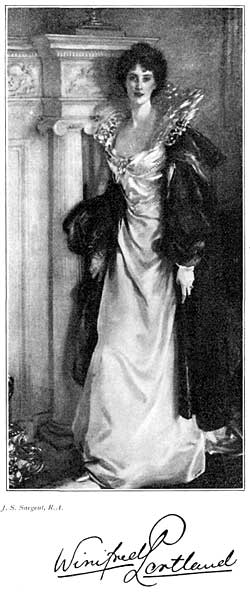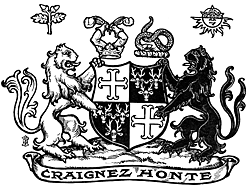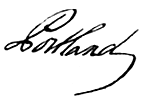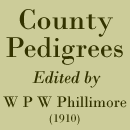Bentinck, Duke of Portland


THE DUKE OF PORTLAND, K.G., G.C.V.O., William John Arthur Charles James Cavendish-Bentinck, Marquess of Titchfield, Earl of Portland, Viscount Woodstock, Baron Cirencester, and Baron Bolsover. Born at Kinnaird House, co. Perth (the residence of his maternal grandfather), 28 December 1857; educated at Eton; Lieut. Coldstream Guards 1877-80, Lieut-Col. Hon. Artillery Company of London 1881-83, and Hon. Col. 4th Batt. Sherwood Foresters since 1889, and of 1st Notts Rifle Vol., and 1st Lanarkshire Vol. Artillery; Master of the Horse 1886-92, and from July 1895 to 1905; Provincial Master Notts Freemasons since 1898; Knight of Justice of St. John of Jerusalem; appoints two Family Trustees of the British Museum; Deputy-Lieut, for co. Ayr; County Councillor for Notts (Mansfield Woodhouse Div.); Lord Lieut, for Caithness 1889, and Nottinghamshire 1898. Succeeded his cousin as 6th Duke in 1879, and his stepmother as Baron Bolsover in 1893.
Married, at St. Peter's, Eaton Square, 11 June 1889, Winifred Anna, only daughter of Thomas Yorke Dallas-Yorke of Walmsgate, Lincolnshire (by Frances Perry, daughter of William Graham of Burntshiels); born at Murtley Castle, co. Perth, 6 September 1863. Children:—
i. Victoria Alexandrina Violet, for whom Queen Victoria stood sponsor in person, born at 3, Grosvenor Square, 28 February 1890.
ii. William Arthur Henry Cavendish-Bentinck, Marquess of Litchfield, born at 3, Grosvenor Square, 16 March 1893; educated at Eton.
iii. Francis Morven Dallas Cavendish-Bentinck, born at Langwell, 27 July 1900.
Residences: Welbeck Abbey, Notts; Bothal Castle, Northumberland; Fullarton House, Ayrshire; Langwell, Caithness. Town House: 3, Grosvenor Square, W. CLUBS: Guards, Turf, White's, Marlborough, Carlton, Bachelors, Hurlingham.
ARMS recorded at Heralds' College: Quarterly—1st and 4th, azure, a cross moline argent, for Bentinck; 2nd and 3rd, sable, three stags' heads caboshed argent, attired or, a crescent for difference, for CAVENDISH.
CRESTS: i. Out of ducal coronet gold, two arms counter-embowed, vested gules, on the hands gloves or, each holding an ostrich feather argent, for BENTINCK. 2. On a wreath argent and sable, a snake nowed proper, for CAVENDISH.
SUPPORTERS: Two lions double queued, the dexter or the sinister sable.
MOTTO: "Craignez honte," formerly "Quo fata vocant."
BADGES for Ogle: i. A slip of oak fructed with two acorns or.
2. A semi-rose, part of the badge of the royal house of York, the sun radiating from the base.
ANCESTRY.—The family of Bentinck is known to have been settled, as early as the thirteenth century, in the Duchy of Guelder, and they appear to have derived their name from the castle of Benting or Bentinck, between Zutphen and Deventer. Their pedigree has been traced in detail thirteen generations prior to William Bentinck's settlement in England in the seventeenth century, and it may be noted that there still flourish in Holland several branches of the house of Bentinck. The English branch descends from the fourth son of Freiheer Bernhard Bentinck of Diepenheim, in the province of Overyssel, who died in 1668. He was the father of nine children, amongst whom was the first Earl of Portland, with whom we accordingly commence the pedigree:—
 I. WILLIAM BENTINCK, EARL OF PORTLAND, Viscount Woodstock and Baron Cirencester, being so created 9 April 1689. Born 20 July 1649; died, "after a fever of twelve days", at his seat at Bulstrode Park, Buckinghamshire, 23 November 1709, and was buried 3 December 1709, at Westminster, "in the vault at the east end of King Henry VII's chapel", and was succeeded by his eldest son as below.
I. WILLIAM BENTINCK, EARL OF PORTLAND, Viscount Woodstock and Baron Cirencester, being so created 9 April 1689. Born 20 July 1649; died, "after a fever of twelve days", at his seat at Bulstrode Park, Buckinghamshire, 23 November 1709, and was buried 3 December 1709, at Westminster, "in the vault at the east end of King Henry VII's chapel", and was succeeded by his eldest son as below.
The Earl of Portland, founder of the House of Bentinck in England, was the fourth son of Bernhard Bentinck of Diepenheim, in Overyssel. He was Page of Honour and Gentleman of the Bedchamber to William, Prince of Orange, whom he accompanied to England on that prince's accession to the English throne as William III in 1688. He was sworn of the Privy Council 14 February 1689, Keeper of the Privy Purse 1689, Superintendent of the Royal Gardens 8 June 1689.
Prior to this, when in Holland, he was in command of a Dutch Regiment of Horse Guards 1672; Bailiff and Stadtholder of Breda 1674; Bailiff and Stadtholder of Lingen 1675; Lieutenant Forester in Holland and West Friesland 1681; created D.C.L. Oxon. 1670; Envoy to England 4 June 1677 and July 1685, and to Berlin in 1685.
He was appointed Lieut.-General in Ireland 1 July 1690, and was engaged in the battle of the Boyne; Commissioner of Greenwich Hospital 20 February 1695; elected 19 February and installed 15 March 1697 as Knight of the Garter; Ranger of Windsor Great Park 20 May 1697 to 7 May 1700; General of Horse 1 June 1697; Keeper of the Little Park of Windsor 13 January 1698 to 7 May 1700; Plenipotentiary to France 29 December 1697; Ambassador to discuss terms of treaty with Louis XIV 1 July 1699.

PORTLAND. Recorded in His Majesty's College of Arms.
In the Revolution William Bentinck took an active part, being the confidential agent of the Prince, and continued to be his trusted friend to the end of his life. As was to be expected, he received many grants from the King, and preferment from time to time for his services. A biography of the Earl of Portland becomes of necessity the political history of his time, and can be but briefly summarized here. After the death of King William, the Earl's "visits to his native county seem to have recurred with their usual regularity, and occasionally to have been combined with confidential business of a public nature. . . His domestic life had probably continued to be a happy one, as it had been in the days of his great friend who had taken so warm an interest in the children of his family. They were numerous and settled partly in England, partly in his native land. . . . Patriotism, as well as friendship and loyalty, was prominent amongst the motives which prompted his services. He was wholly unskilled in flattery, and, according to Burnet, 'seemed to have the art of creating many enemies and not one friend'. The Earl of Portland was, during William's reign, 'probably the most unpopular man in this country'. In requital of the unpopularity to which he was exposed, Portland's name will always be remembered as inseparable from the history of the most important political transactions of William III's reign."
The Earl of Portland married, (i) I Feb. 1678, Anne, daughter of Sir Edward Villiers, Knight-Marshal; she was Maid of Honour to the Princess Mary, and sister of Edward, 1st Earl of Jersey, and died at Zorgvliet, in Holland, 20 Nov. 1688. Children:—
i. William Bentinck, born at the Hague; died young.
ii. Henry Bentinck, his successor, of whom next.
i. Mary, mar. (1) Algernon (Capel), Earl of Essex, and (2) the Hon. CONYERS DARCY.
ii. Anne Margaret, mar., 1701, Arend van Wassenaer, Baron van Wassenaer-Duivenvoorde, Ambassador from Holland to the English Court.
iii. Frances Wilhelmina, mar. William, fourth Lord Byron.
iv. Eleanora Sophia, died unmarried.
v. Isabella, mar. Evelyn (Pierrepont), Duke of Kingston.
The Earl of Portland married, by special licence, (2) at Chiswick, Middlesex, 12 May 1700, Jane Martha, Dowager Lady Berkeley of Stratton, and 6th daughter of Sir John Temple, Bart., of East Sheen, Surrey.
By her, who died 25 Mar. 1751:—
iii. William Bentinck, of Rhoon and Pendrecht, Holland, and of Terrington St. Clement's, Norfolk; born 6 Nov. 1704; created, 29 Dec. 1732, a Count of the Holy Roman Empire. He mar. and left two sons, whose descendants settled some in Holland, others in England.
iv. Charles John Bentinck, born at Bulstrode, 2 June 1708; mar., 11 Jan. 1739, Lady Margaret Cadogan; died 9 Mar. 1779.
vi. Sophia, born at Whitehall, 4 Apr. 1701; mar., 24 Mar. 1728, Henry (de Grey), Duke of Kent.
vii. Elizabeth Adriana, born at Whitehall, 27 June 1703; mar., 18 Dec. 1720, Henry Egerton, Bishop of Hereford; died 1765.
viii. Henrietta, born at Whitehall, 12 Dec. 1705; mar., 15 Oct. 1728, James (Hamilton), Viscount Limerick, Earl of Clanbrassil ; died 1792.
ix. Barbara, born at Bulstrode, 20 Oct. 1709; mar., 1734, Francis Godolphin, afterwards 2nd Lord Godolphin; died 1 Apr. 1736.
The Earl of Portland was succeeded by his son :—
 II. HENRY BENTINCK, Earl of Portland till 6 July 1716, when
he was created Marquess of Titchfield and DUKE OF PORTLAND.
Styled Viscount Woodstock from 1689 to 1709, He was born 17 Mar. 1682,
at the Hague, died
II. HENRY BENTINCK, Earl of Portland till 6 July 1716, when
he was created Marquess of Titchfield and DUKE OF PORTLAND.
Styled Viscount Woodstock from 1689 to 1709, He was born 17 Mar. 1682,
at the Hague, died
in Jamaica, 4 July
1726, and was buried
3 Nov. 1726 in the
Duke of Ormonde's
vault in Westminster
Abbey. Will dated
9 August 1722, proved 14 Feb. 1727. M.P. for Southampton 1705, for
Hampshire 1708-9; Captain and Colonel 1st Troop of Horse Guards
21 July 1710; Lord of the Bedchamber to King George I 16 July 1717;
created LL.D. Cambridge 7 Oct. 1717, and appointed Governor and
Captain-General of Jamaica 31 Oct. 1721, and Vice-Admiral 13 Dec. 1721.
The Duke of Portland married, by licence, at Chiswick, 9 June 1704, Lady Elizabeth Noel, eldest daughter and co-heir of Wriothesley Baptist, 2nd Earl of Gainsborough. She survived him, and was buried at Titchfield, March 1736-7. Children:—
i. William Bentinck, 2nd Duke of Portland, of whom next.
ii. George Bentinck, colonel of the fifth infantry regiment; M.P. for Droitwich 1742-7, Grampound 1747-54, and Malmesbury 1754-9; born 27 Dec. 1715, died 1 March 1759, at Bath, and was bur. at Heston, Middlesex.
i. Anne, mar. Colonel Daniel Paul, and died in July 1749.
ii. Isabella, mar., 8 Nov. 1739, Henry Monck, of Charleville, co. Wicklow, and died 1783.
iii. Amelia Catherine, mar., 24 Dec. 1747, Jacob Arend van Wassenaer, Baron van Wassenaer, and died in 1756.
The Duke was succeeded by his son :—
 III. WILLIAM BENTINCK, 2nd DUKE OF PORTLAND,
K.G., styled Viscount Woodstock 1709-
16, Marquess of Titchfield 1716-26; born
1 March 1709; died 1 May 1762, in his
54th year, and was buried, 8 May, in Westminster Abbey, in the Duke of
Ormonde's vault.
III. WILLIAM BENTINCK, 2nd DUKE OF PORTLAND,
K.G., styled Viscount Woodstock 1709-
16, Marquess of Titchfield 1716-26; born
1 March 1709; died 1 May 1762, in his
54th year, and was buried, 8 May, in Westminster Abbey, in the Duke of
Ormonde's vault.
Governor of the Foundling Hospital, 7 Aug. 1739; F.R.S., 6 Dec. 1739; K.G., 20 March 1741; a Family Trustee of the British Museum, 11 Dec. 1753; created D.C.L. Oxford, 5 March 1755. "A man rather calculated for the virtues and enjoyments of a literary and private life."
The Duke of Portland married, at St. Marylebone, 11 June 1734, Margaret Cavendish Harley* only daughter and heir of Edward (Harley), 2nd Earl of Oxford (by Lady Henrietta Cavendish Holles); born 11 Feb., bapt. 19 March 1714-15. She, who was celebrated by Prior as "my noble lovely little Peggy", died 17 July 1785, in her 71st year, and was buried, 30 July, in the Duke of Ormonde's vault in Westminster Abbey. Children:—
i. William Henry Bentinck, 3rd Duke of Portland, of whom next.
ii. Edward Charles Bentinck, born 3 March 1744, died at Brussels, 8 Oct. 1819; educated at Christ Church, Oxford; matriculated 7 Nov. 1761; M.P. 1774-1802; mar. Elisabeth, dau. of Richard Cumberland, who died 1837, leaving issue.
i. Elizabeth, mar. Thomas (Thynne), 1st Marquess of Bath.
ii. Henrietta, mar. George Harry (Grey), 5th Earl of Stamford and Warrington.
iii. Margaret, died, unmarried, 28 April 1756.
iv. Frances, died, unmarried, in March 1743.
The 2nd Duke was succeeded by his son :—
 IV. WILLIAM HENRY CAVENDISH-BENTINCK, 3rd DUKE OF PORTLAND, KG., styled Marquess of Titchfield 1738-62; born 14 April 1738; died at Bulstrode 30 Oct. 1809; buried at St. Marylebone, 9 Nov.
IV. WILLIAM HENRY CAVENDISH-BENTINCK, 3rd DUKE OF PORTLAND, KG., styled Marquess of Titchfield 1738-62; born 14 April 1738; died at Bulstrode 30 Oct. 1809; buried at St. Marylebone, 9 Nov.
He was educated at Westminster and Christ Church, Oxford; matriculated 4 March 1755; M.A. 1 Feb. 1757; M.P. for Weobley 1761-62; a Family Trustee of the British Museum, 1764; Lord Chamberlain of the Household 10 July 1765 to 26 Nov. 1766; Privy Councillor 10 July 1765; F.R.S. 5 June 1766; Viceroy of Ireland 10 April to 15 Sept. 1782; LL.D. Dublin 1782 High Steward of Bristol 1786; Chancellor of the University of Oxford 27 Sept. 1792; created D.C.L. by diploma 7 Oct. 1792; Recorder of Nottingham June 1794; Secretary of State for the Home Department 11 July 1794 to 30 July 1801; Lord-Lieutenant and Custos Rotulorum for Notts 10 June 1795; Steward, Keeper, and Warden of the Forest of Sherwood and Park of Folewood 30 June 1795; Governor of the Charter House 2 Dec. 1796; Elder Brother of the Trinity House 12 June 1797; Custos Rotulorum for Northumberland 27 June 1800 to 19 May 1802; KG. 16 July 1801, having been elected in 1794; Lord President of the Council 30 July 1801 to 14 Jan. 1805; a member of the Cabinet, without office, Jan. 1805 to Jan. 1806 First Lord of the Treasury 31 March 1807 to 28 Sept. 1809.
The third Duke of Portland, who succeeded his father at the age of 24, had entered Parliament as M.P. for Weobley two years before, and became a member of Lord Rockingham's first Government in 1765, as Lord Chamberlain. He took an active part in politics, belonging to the Whig party, as was natural, and, in 1783, became Prime Minister, with Lord North and Fox as Secretaries of State, but this coalition Cabinet fell the same year, and for a time he left the active duties of political leader of the opposition to Fox and Burke, retiring to his country seat. The tendencies of the French Revolution alarmed the great Whig houses, and the Duke of Portland, after some hesitation, joined Pitt's Government. He himself was Home Secretaiy from 1794 to 1801, and though the repressive acts brought about by dread of the French Revolution placed an enormous power in the Duke's hands, his administration of the Home Office "was marked by no straining of his powers and by no consequent unpopularity of the Government". He has been described as a "tolerant man of the world, not a man of great ability, but of great experience, who knew the advantage of leaving the expression of public opinion as free as possible".
In Addington's administration he became Lord President of the Council, continuing as such until January 1805. He held no office in the "Ministry of all the Talents", but in 1807 he again became Premier, he being the only man under whom the rivals Canning and Lord Castlereagh would serve. He was old and feeble, but from a high sense of public duty, though unwillingly, accepted the burden. The duel on Wimbledon Common between those two statesmen resulted in their resignation, and the Duke, whose health was rapidly declining, insisted on retiring; and his death followed a few weeks later.
"Few statesmen have suffered more obloquy." Yet he has been described in the Dictionary of National Biography as a "good administrator, tolerant in his exercise of great and extraordinary powers, careful in details, and yet not wanting in broad statesmanlike views. In private life he was in every way admirable."
In consequence of his descent from the Cavendish Dukes of Newcastle through his mother, he, by Royal Licence, 5 Oct. 1801, assumed for himself and issue the additional surname and arms of Cavendish.
He married, at Burlington House, Piccadilly, 8 November 1766, Dorothy Cavendish, only daughter of William, 4th Duke of Devonshire, who died 3 June 1794, aged 43 years, and was buried at St. Maryle-bone 14 June. Children:—
i. William Henry Cavendish-Bentinck, 4th Duke, of whom next.
ii. William Henry Cavendish-Bentinck, born 14 September 1774; died, s.p., 17 June 1839; educated at Ealing and Westminster Schools; G.C.B., G.C.H., Governor-General of India, 1827 to 1835; M.P. for Glasgow 1836 to 1839; mar., 19 February 1803, Mary Acheson, 2nd dau. of Arthur, 1st Earl of Gosford.
He entered the army, in 1791, as an ensign in the Coldstream Guards, becoming Captain in 2nd Light Dragoons 1792, and, on 20 May 1794, Lieut.-Col. of the 24th Light Dragoons. He served in the Netherlands and in North Italy in 1799 to 1801. From 1803 to 1807 he was Governor of Madras, from which he was recalled in consequence of the mutiny at Vellore, caused, it was thought, by the regulations introduced by the Government. Subsequently, having been promoted as Major-General, he took part in the Peninsular War, and commanded a brigade at Corunna. From 1811 to 1814 he was envoy to, practically Governor of, Sicily. At the close of the war he was 13 years unemployed, but, in 1827, was appointed Governor of Bengal, becoming, in 1833, the first Governor-General of India. He resigned the Government 1835 "much regretted by Europeans and natives", and a statue in his honour was erected at Calcutta. "There can be no question that Bentinck's Indian administration must be regarded as a marked era in the history of Indian progress. He was the first British statesman entrusted with the government of India who declared and acted upon the policy of governing India in the interests of the people of that country."
iii. William Charles Augustus Cavendish-Bentinck, of whom hereafter.
iv. Frederick Cavendish-Bentinck, C.B., Major-General in the Army; M.P. for Weobley 1816-1824, and Queenborough 1824-1826; born 2 Nov. 1781; died 11 Feb. 1828; mar. Mary Lowt/wr, dau. of William, Earl of Lonsdale, who died 21 Oct. 1862, leaving a son.
* It may be noted here that Welbeck descended to this lady upon the death of her mother, the Countess of Oxford, in 1755. The third Duke lived chiefly at Welbeck until his mother's death in 1785, alter which he lived principally at Bulstrode Park, and in 1795 transferred Welbeck to his eldest son upon his marriage. Bulstrode was sold after the death of the third Duke to the Duke ot Somerset.
